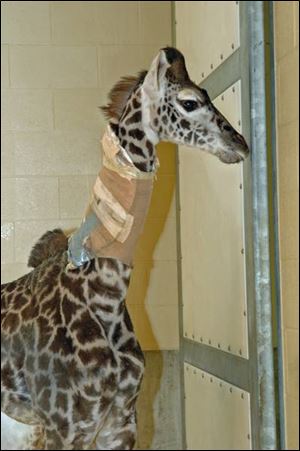
Young giraffe ailing again as 2 vertebrae in neck start to fuse
2/9/2006
Zahara, the five-month-old giraffe, is on antibiotics again, and her neck has been wrapped in a brace for stability.
Zahara's nearly trebled her weight, topped 7 feet on the growth chart, and seems as robust as a young giraffe could be, yet the Toledo Zoo's five-month-old Masai giraffe is in trouble.
"Her prognosis is guarded. It is serious," Dr. Wynona Shellabarger, the zoo's chief veterinarian, said.
About a month ago, keepers noticed a bump on Zahara's long neck. The young female walked stiffly and moved her head ever-so-carefully.
After a hands-on exam that required the assistance of six helpers to hold the lightly sedated youngster in place, and consultations with veterinarians around the country, Dr. Shellabarger decided to wrap Zahara's neck in a splint.
A few weeks of splinting seemed to do the trick, and Zahara not only acted more comfortable, but her bump was gone. But the knot reappeared soon after, and a subsequent X-ray revealed that two of her seven cervical vertebrae near the center of her neck are fusing.
Why they are isn't certain. It could be the result of a healing fracture, Dr. Shellabarger said. But no one can say when such an accident occurred.
The animal has been housed alone almost since it was born after its mother refused to nurse.
It's also possible that the X-ray is actually revealing bone loss from infection rather than bone remodeling from a fracture. Dr. Shellabarger speculates that a bacterial infection diagnosed in Zahara shortly after birth settled in her neck despite antibiotic treatment.
"It's one of the things we're
postulating," she said.
As a consequence, the giraffe is on antibiotics again, and her neck is wrapped in a brace for stability. Surgical intervention for Zahara's injury is unlikely, the veterinarian said, because of the extreme risks involved in anesthesizing giraffes.
Veterinarians at Ohio State University who have seen infections in neck vertebrae in llamas and alpacas no longer perform surgery for such problems.
"They've gotten to the point where they've lost enough animals from the anesthesia. They've come back full circle and now manage these animals conservatively, using antibiotics and stall rest,'' Dr. Shellabarger said
While the zoo staff hopes the current treatment will do the trick, if it fails, the results are potentially devastating.
"It could turn out the damaged area won't be able to stabilize ... and ultimately will impinge on the spinal cord and damage the spinal cord.''
"To look at her, you wouldn't guess it,'' Dr. Shellabarger said. For one thing, her appetite is robust. She's about 300 pounds today. She weighed 111 pounds at birth.
"She's not in any degree of pain. She's eating normally, continuing to grow. She's outgrowing her current splint.''
Contact Jenni Laidman at:
jenni@theblade.com
or 419-724-6507.